

Compact Muon Solenoid
LHC, CERN
| CMS-B2G-20-004 ; CERN-EP-2024-030 | ||
| Search for resonant pair production of Higgs bosons in the $ \mathrm{b}\overline{\mathrm{b}}\mathrm{b}\overline{\mathrm{b}} $ final state using large-area jets in proton-proton collisions at $ \sqrt{s}= $ 13 TeV | ||
| CMS Collaboration | ||
| 18 July 2024 | ||
| JHEP 02 (2025) 040 | ||
| Abstract: A search is presented for the resonant production of a pair of standard model-like Higgs bosons using data from proton-proton collisions at a centre-of-mass energy of 13 TeV, collected by the CMS experiment at the CERN LHC in 2016-2018, corresponding to an integrated luminosity of 138 fb$ ^{-1} $. The final state consists of two b quark-antiquark pairs. The search is conducted in the region of phase space where at least one of the pairs is highly Lorentz-boosted and is reconstructed as a single large-area jet. The other pair may be either similarly merged or resolved, the latter reconstructed using two b-tagged jets. The data are found to be consistent with standard model processes and are interpreted as 95% confidence level upper limits on the product of the cross sections and the branching fractions of the spin-0 radion and the spin-2 bulk graviton that arise in warped extradimensional models. The limits set are in the range 9.74-0.29 fb and 4.94-0.19 fb for a narrow radion and a graviton, respectively, with masses between 1 and 3 TeV. For a radion and for a bulk graviton with widths 10% of their masses, the limits are in the range 12.5-0.35 fb and 8.23-0.23 fb, respectively, for the same masses. These limits result in the exclusion of a narrow-width graviton with a mass below 1.2 TeV, and of narrow and 10%-width radions with masses below 2.6, and 2.9 TeV, respectively. | ||
| Links: e-print arXiv:2407.13872 [hep-ex] (PDF) ; CDS record ; inSPIRE record ; HepData record ; CADI line (restricted) ; | ||
| Figures | |
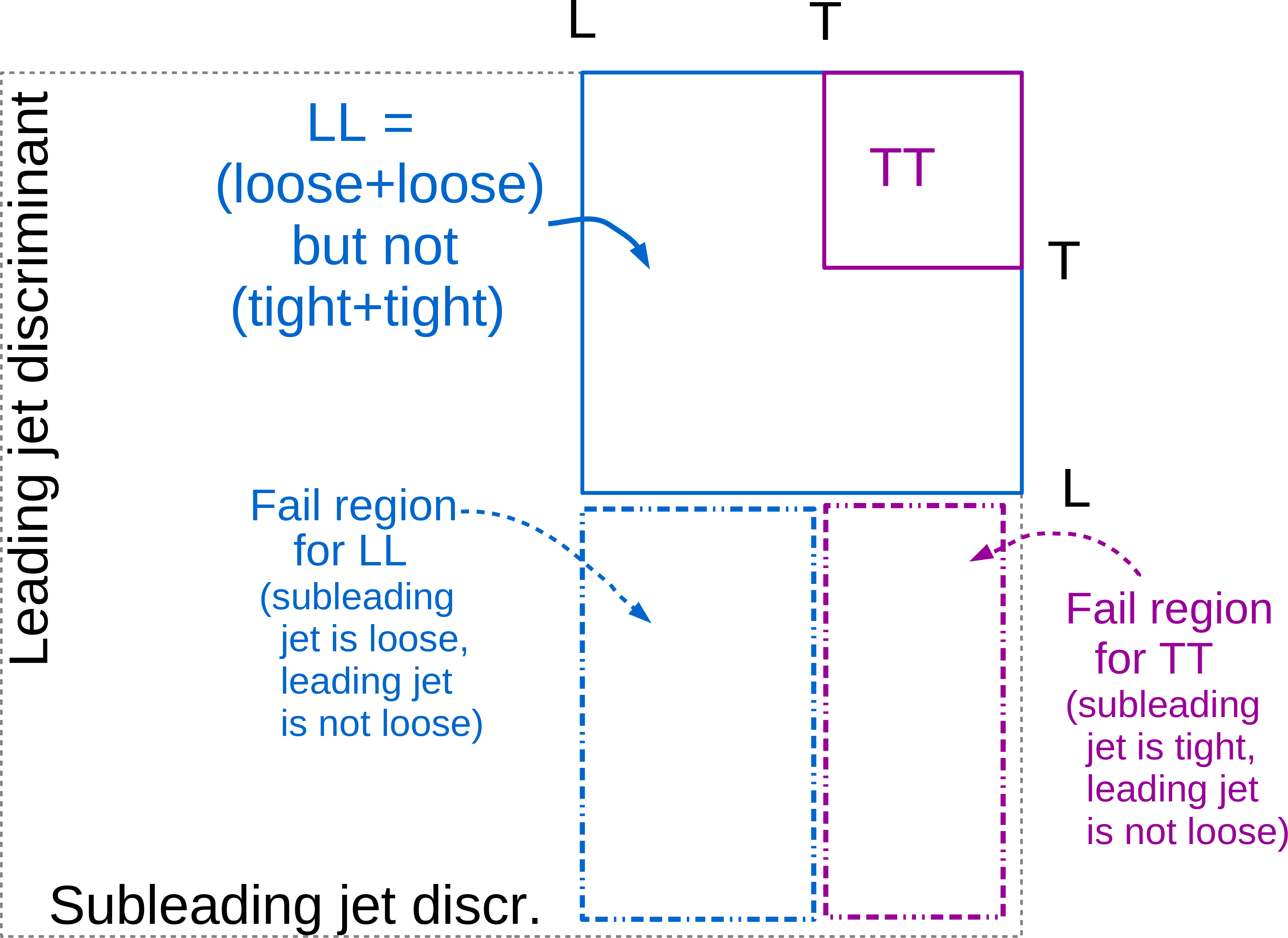
png pdf |
Figure 1:
A diagram showing tight-tight (TT, purple) and loose-loose (LL, blue) pass regions (solid) and their corresponding fail regions (dash-dotted). |
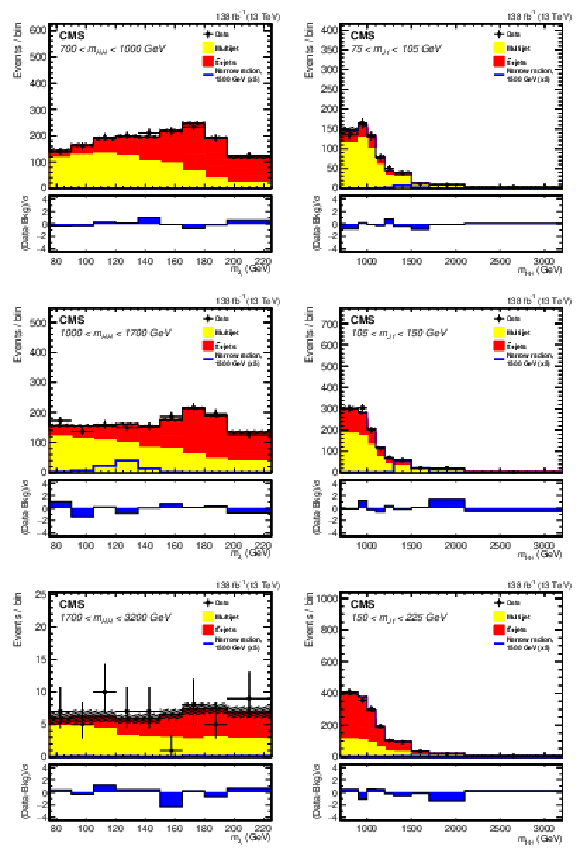
png pdf |
Figure 2:
Slices of 2D distributions of observed events and the post-fit templates in the LL signal region, projected onto the plane of leading jet mass $ m_{\text{J}_{1}} $ (left) and corrected HH mass $ m_\text{HH} $ (right) axes, together with the signal expected for a radion of mass 1.5 TeV. For this and following figures, the value of $ \sigma $ in the lower panel is $ \sigma = \sqrt{\sigma_\text{bkg}^2 + \sigma_\text{data}^2} $, where $ \sigma_\text{bkg} $ is the total uncertainty in the background and $ \sigma_\text{data} $ is the statistical uncertainty associated with the number of data events in a particular bin. |
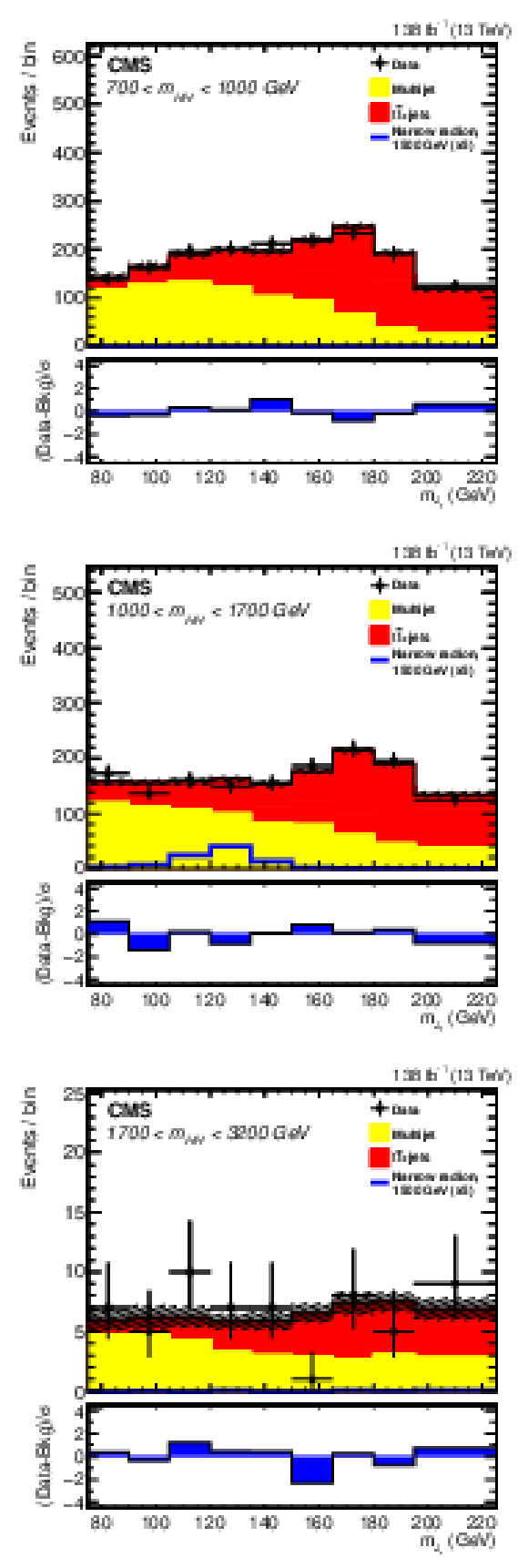
png pdf |
Figure 2-a:
Slices of 2D distributions of observed events and the post-fit templates in the LL signal region, projected onto the plane of leading jet mass $ m_{\text{J}_{1}} $ (left) and corrected HH mass $ m_\text{HH} $ (right) axes, together with the signal expected for a radion of mass 1.5 TeV. For this and following figures, the value of $ \sigma $ in the lower panel is $ \sigma = \sqrt{\sigma_\text{bkg}^2 + \sigma_\text{data}^2} $, where $ \sigma_\text{bkg} $ is the total uncertainty in the background and $ \sigma_\text{data} $ is the statistical uncertainty associated with the number of data events in a particular bin. |

png pdf |
Figure 2-b:
Slices of 2D distributions of observed events and the post-fit templates in the LL signal region, projected onto the plane of leading jet mass $ m_{\text{J}_{1}} $ (left) and corrected HH mass $ m_\text{HH} $ (right) axes, together with the signal expected for a radion of mass 1.5 TeV. For this and following figures, the value of $ \sigma $ in the lower panel is $ \sigma = \sqrt{\sigma_\text{bkg}^2 + \sigma_\text{data}^2} $, where $ \sigma_\text{bkg} $ is the total uncertainty in the background and $ \sigma_\text{data} $ is the statistical uncertainty associated with the number of data events in a particular bin. |

png pdf |
Figure 3:
Slices of 2D distributions of observed events and the post-fit templates in the TT signal region, projected onto the $ m_{\text{J}_{1}} $ (left) and $ m_\text{HH} $ (right) axes, together with the signal expected for a radion of mass 1.5 TeV. |
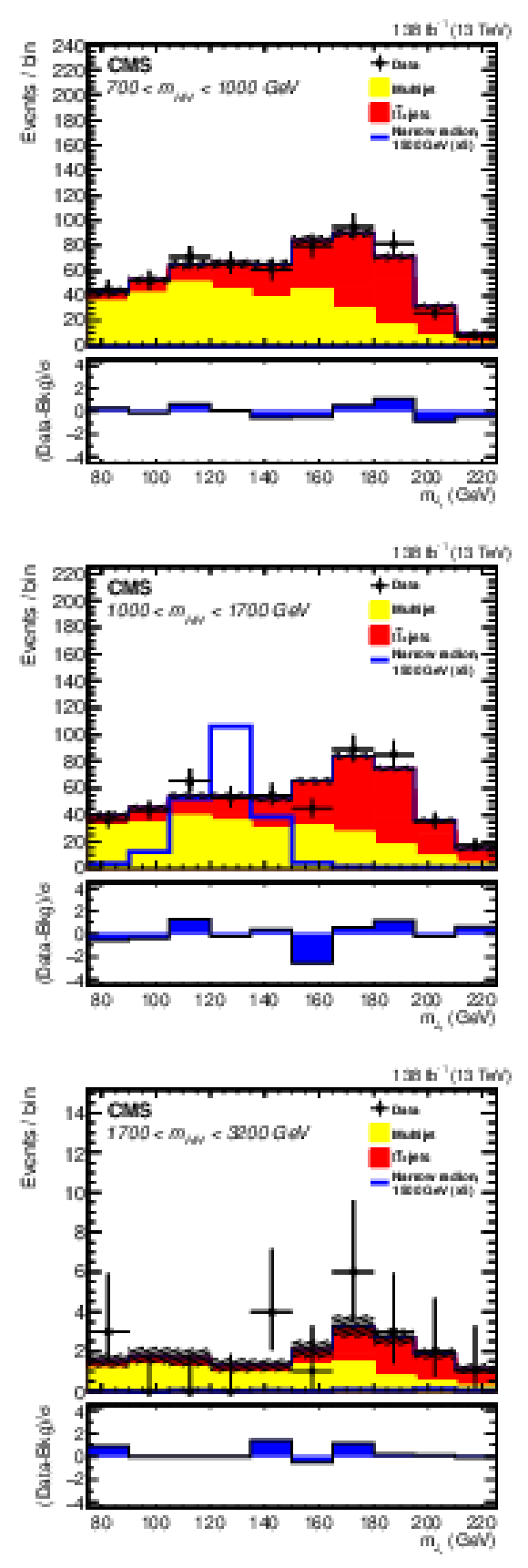
png pdf |
Figure 3-a:
Slices of 2D distributions of observed events and the post-fit templates in the TT signal region, projected onto the $ m_{\text{J}_{1}} $ (left) and $ m_\text{HH} $ (right) axes, together with the signal expected for a radion of mass 1.5 TeV. |
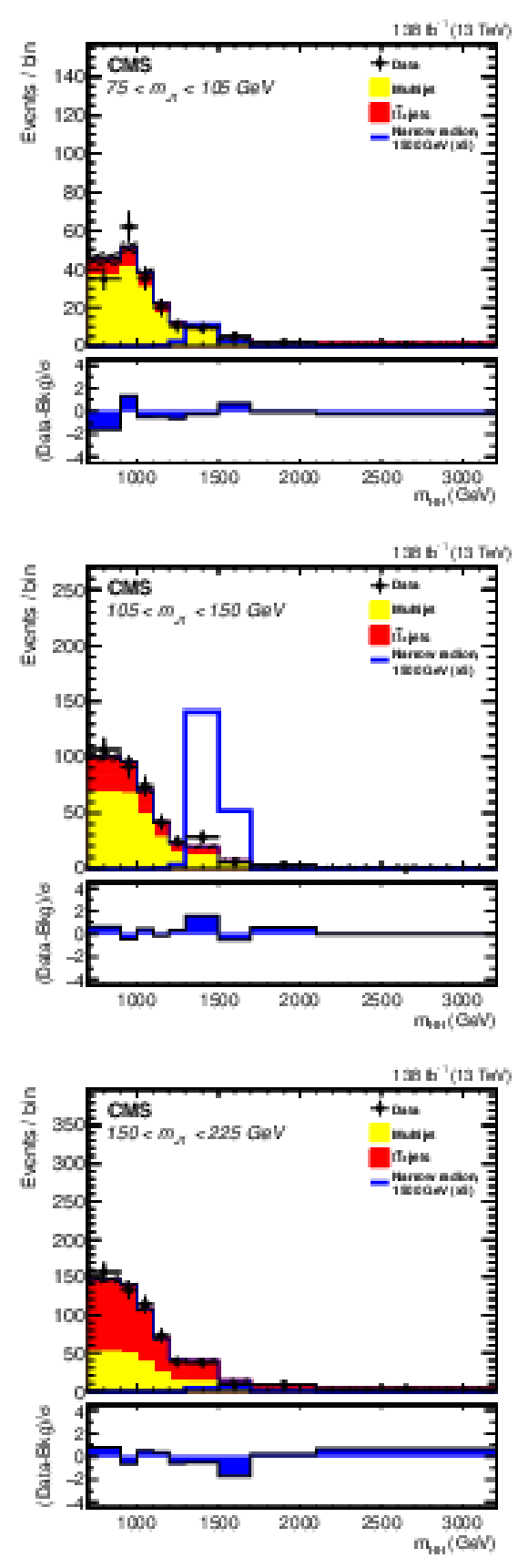
png pdf |
Figure 3-b:
Slices of 2D distributions of observed events and the post-fit templates in the TT signal region, projected onto the $ m_{\text{J}_{1}} $ (left) and $ m_\text{HH} $ (right) axes, together with the signal expected for a radion of mass 1.5 TeV. |
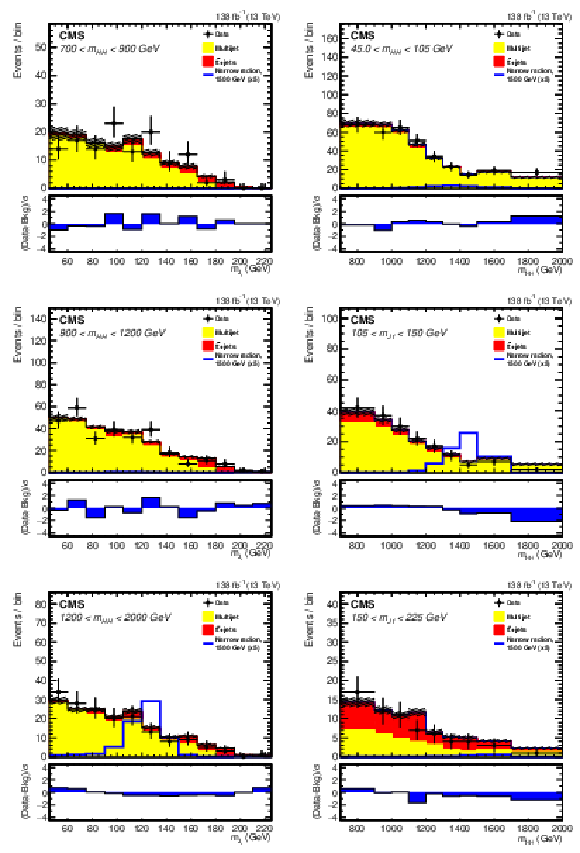
png pdf |
Figure 4:
Slices of 2D distributions of observed events and the post-fit templates in the semi-resolved signal region, projected onto the $ m_{\text{J}_{1}} $ (left) and $ m_\text{HH} $ together with the signal expected for a radion of mass 1.5 TeV. |
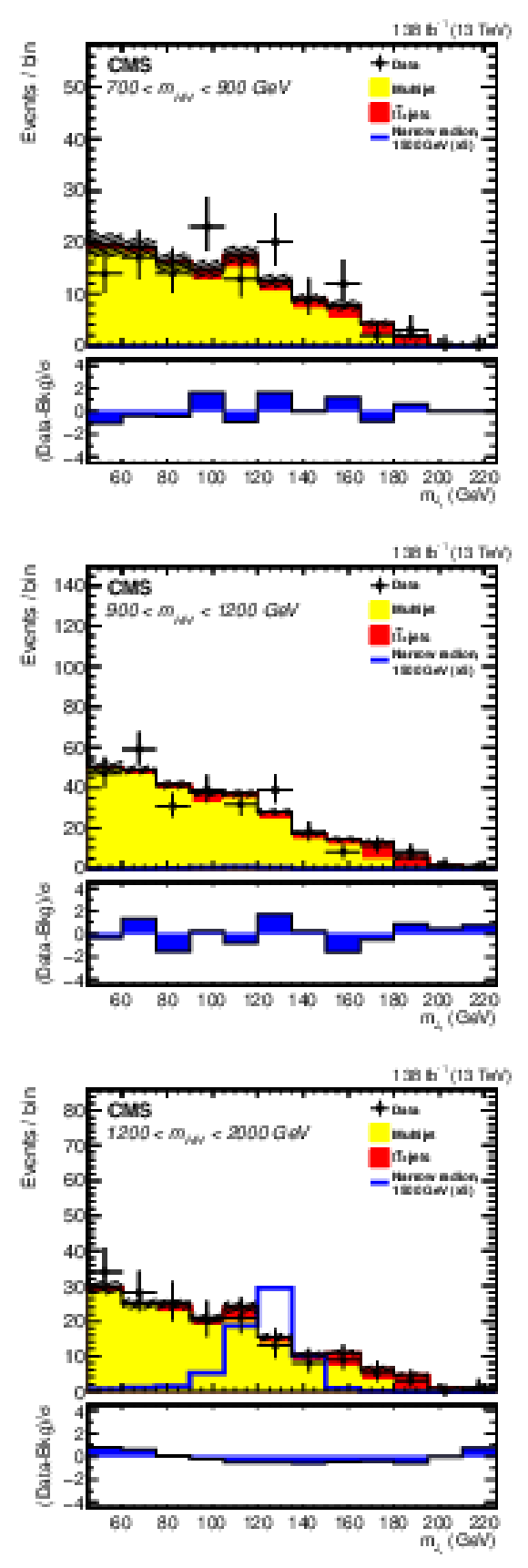
png pdf |
Figure 4-a:
Slices of 2D distributions of observed events and the post-fit templates in the semi-resolved signal region, projected onto the $ m_{\text{J}_{1}} $ (left) and $ m_\text{HH} $ together with the signal expected for a radion of mass 1.5 TeV. |
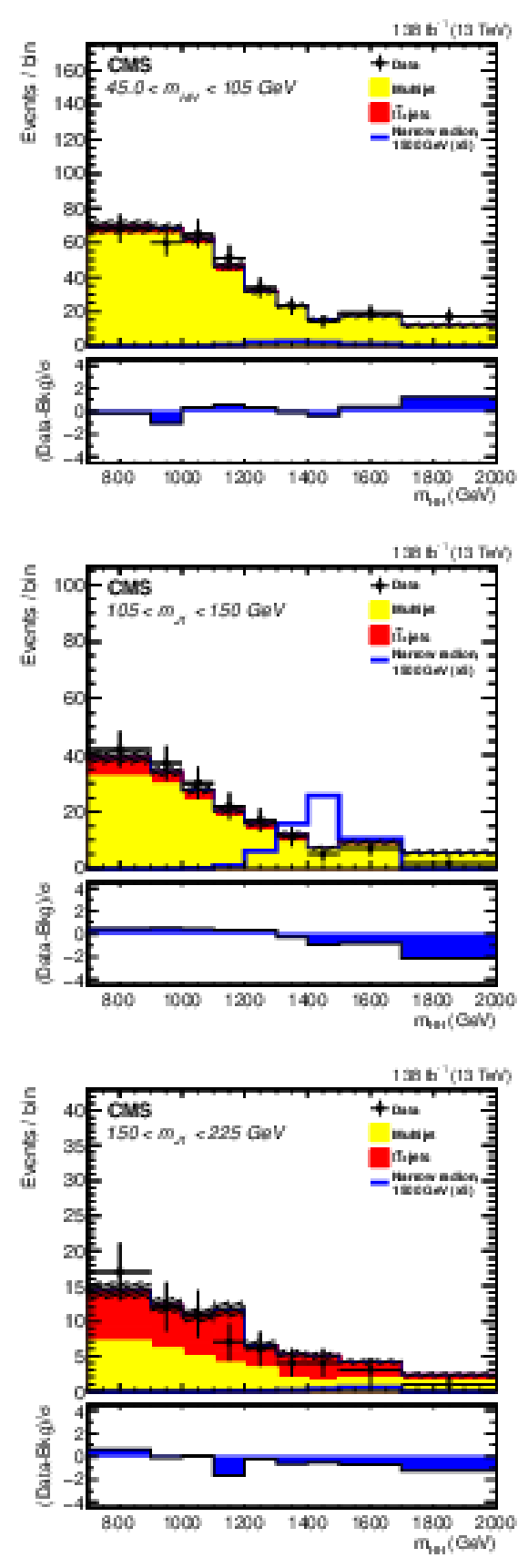
png pdf |
Figure 4-b:
Slices of 2D distributions of observed events and the post-fit templates in the semi-resolved signal region, projected onto the $ m_{\text{J}_{1}} $ (left) and $ m_\text{HH} $ together with the signal expected for a radion of mass 1.5 TeV. |
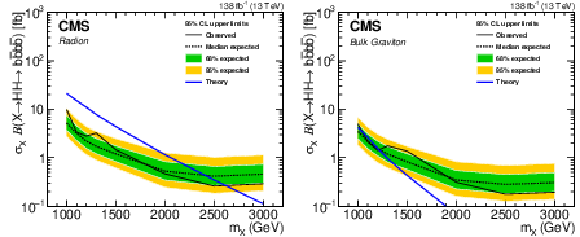
png pdf |
Figure 5:
The observed (solid black line) and expected (dashed black line) upper limits at 95% CL on $ \sigma(\mathrm{p}\mathrm{p}\to\mathrm{X}) \mathcal{B}(\mathrm{X}\to \mathrm{H}\mathrm{H}\to \mathrm{b}\overline{\mathrm{b}}\mathrm{b}\overline{\mathrm{b}}) $ for a narrow spin-0 radion (left, corresponding to $ \Lambda_{\text{R}}= $ 3 TeV) and a narrow width spin-2 bulk graviton (right, corresponding to $ k/\overline{M}_\text{Pl} = $ 0.5) models. The green (yellow) bands represent one (two) standard deviations from the expected limit. The predicted theoretical cross sections for the narrow radion and bulk graviton are also shown. |
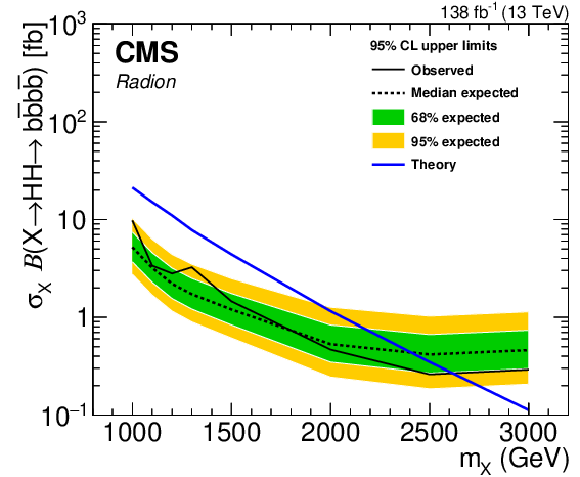
png pdf |
Figure 5-a:
The observed (solid black line) and expected (dashed black line) upper limits at 95% CL on $ \sigma(\mathrm{p}\mathrm{p}\to\mathrm{X}) \mathcal{B}(\mathrm{X}\to \mathrm{H}\mathrm{H}\to \mathrm{b}\overline{\mathrm{b}}\mathrm{b}\overline{\mathrm{b}}) $ for a narrow spin-0 radion (left, corresponding to $ \Lambda_{\text{R}}= $ 3 TeV) and a narrow width spin-2 bulk graviton (right, corresponding to $ k/\overline{M}_\text{Pl} = $ 0.5) models. The green (yellow) bands represent one (two) standard deviations from the expected limit. The predicted theoretical cross sections for the narrow radion and bulk graviton are also shown. |

png pdf |
Figure 5-b:
The observed (solid black line) and expected (dashed black line) upper limits at 95% CL on $ \sigma(\mathrm{p}\mathrm{p}\to\mathrm{X}) \mathcal{B}(\mathrm{X}\to \mathrm{H}\mathrm{H}\to \mathrm{b}\overline{\mathrm{b}}\mathrm{b}\overline{\mathrm{b}}) $ for a narrow spin-0 radion (left, corresponding to $ \Lambda_{\text{R}}= $ 3 TeV) and a narrow width spin-2 bulk graviton (right, corresponding to $ k/\overline{M}_\text{Pl} = $ 0.5) models. The green (yellow) bands represent one (two) standard deviations from the expected limit. The predicted theoretical cross sections for the narrow radion and bulk graviton are also shown. |
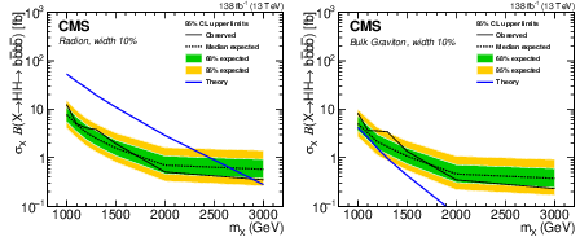
png pdf |
Figure 6:
The observed (solid black line) and expected (dashed black line) upper limits at 95% CL on $ \sigma(\mathrm{p}\mathrm{p}\to\mathrm{X}) \mathcal{B}(\mathrm{X}\to \mathrm{H}\mathrm{H}\to \mathrm{b}\overline{\mathrm{b}}\mathrm{b}\overline{\mathrm{b}}) $ for the 10%-width spin-0 radion (left) and the 10%-width spin-2 bulk graviton (right) models. The green (yellow) bands represent one (two) standard deviations from the expected limit. The predicted theoretical cross sections for the 10%-width radion and bulk graviton are also shown. |
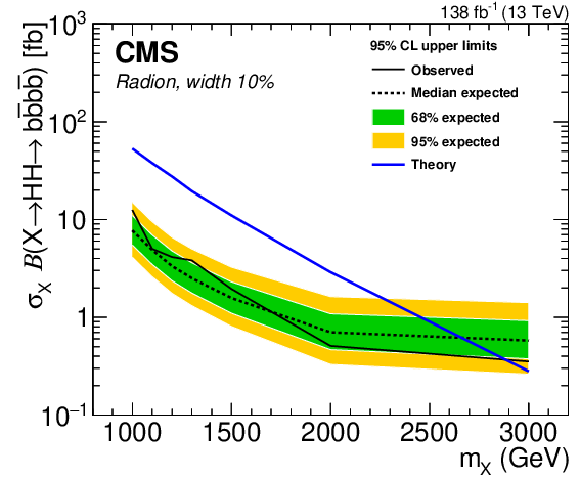
png pdf |
Figure 6-a:
The observed (solid black line) and expected (dashed black line) upper limits at 95% CL on $ \sigma(\mathrm{p}\mathrm{p}\to\mathrm{X}) \mathcal{B}(\mathrm{X}\to \mathrm{H}\mathrm{H}\to \mathrm{b}\overline{\mathrm{b}}\mathrm{b}\overline{\mathrm{b}}) $ for the 10%-width spin-0 radion (left) and the 10%-width spin-2 bulk graviton (right) models. The green (yellow) bands represent one (two) standard deviations from the expected limit. The predicted theoretical cross sections for the 10%-width radion and bulk graviton are also shown. |
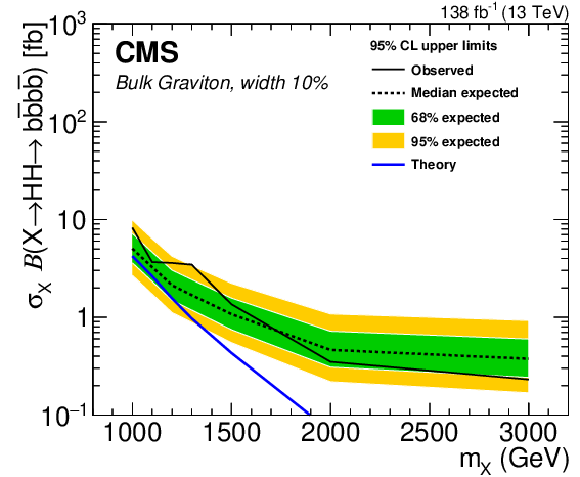
png pdf |
Figure 6-b:
The observed (solid black line) and expected (dashed black line) upper limits at 95% CL on $ \sigma(\mathrm{p}\mathrm{p}\to\mathrm{X}) \mathcal{B}(\mathrm{X}\to \mathrm{H}\mathrm{H}\to \mathrm{b}\overline{\mathrm{b}}\mathrm{b}\overline{\mathrm{b}}) $ for the 10%-width spin-0 radion (left) and the 10%-width spin-2 bulk graviton (right) models. The green (yellow) bands represent one (two) standard deviations from the expected limit. The predicted theoretical cross sections for the 10%-width radion and bulk graviton are also shown. |
| Tables | |

png pdf |
Table 1:
Event selection criteria for the fully-merged topology. |

png pdf |
Table 2:
Event selection criteria for the semi-resolved topology. |
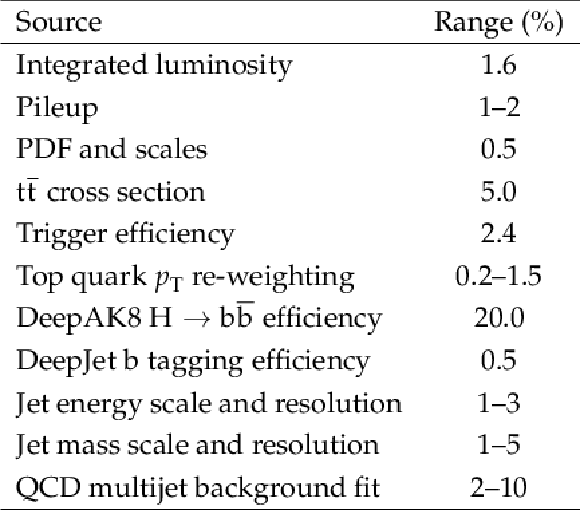
png pdf |
Table 3:
Summary of the ranges within which the systematic uncertainties in the signal and background yields are varied in the combined fit of all ten regions for a radion resonance at 1500 GeV. |
| Summary |
| A search has been presented for the pair production of standard model Higgs bosons (HH) from the decay of a spin-0 radion or a spin-2 bulk graviton as predicted in warped extradimensional models, using data from proton-proton collisions at a centre-of-mass energy of 13 TeV and corresponding to an integrated luminosity of 138 fb$^{-1}$. The search is restricted to the case where each Higgs boson decays to a bottom quark-antiquark pair. It is conducted in the region of phase space where at least one of the Higgs bosons has a large Lorentz boost, so that the $ \mathrm{H}\to\mathrm{b}\overline{\mathrm{b}} $ decay products are collimated to form a single H jet. The search combines events with one H jet and two b jets with events having two H jets, thus adding sensitivity compared with previous analyses [46,48]. The results are interpreted in terms of upper limits on the product of the production cross section for the respective resonance particles and the branching fraction to $ \mathrm{H}\mathrm{H} \to \mathrm{b}\overline{\mathrm{b}}\mathrm{b}\overline{\mathrm{b}} $, at 95% confidence level. The upper limits range from 9.74 to 0.29 fb for a narrow radion and from 4.94 to 0.19 fb for a narrow bulk graviton, each having a mass of 1-3 TeV. Assuming a with of 10% for the radion and the graviton, the limits for the same masses are in the range 12.48-0.35 fb and 8.23-0.23 fb, respectively. As a result, the narrow-width graviton with $ m_{\mathrm{X}} $ below 1.2 TeV, and narrow and 10%-width radion with masses below 2.6 TeV, and 2.9 TeV, respectively, are excluded. |
| References | ||||
| 1 | ATLAS Collaboration | Observation of a new particle in the search for the standard model Higgs boson with the ATLAS detector at the LHC | PLB 716 (2012) 01 | 1207.7214 |
| 2 | CMS Collaboration | Observation of a new boson at a mass of 125 GeV with the CMS experiment at the LHC | PLB 716 (2012) 30 | CMS-HIG-12-028 1207.7235 |
| 3 | CMS Collaboration | Observation of a new boson with mass near 125 GeV in pp collisions at $ \sqrt{s} = $ 7 and 8 TeV | JHEP 06 (2013) 081 | CMS-HIG-12-036 1303.4571 |
| 4 | S. Dawson, S. Dittmaier, and M. Spira | Neutral Higgs boson pair production at hadron colliders: QCD corrections | PRD 58 (1998) 115012 | hep-ph/9805244 |
| 5 | S. Borowka et al. | Higgs boson pair production in gluon fusion at next-to-leading order with full top-quark mass dependence | no.~1, 01, , . [Erratum: Phys.Rev.Lett. 117, 079901 ()], 2016 PRL 117 (2016) |
1604.06447 |
| 6 | J. Baglio et al. | Gluon fusion into Higgs pairs at NLO QCD and the top mass scheme | no.~6, 459, 2019 EPJC 79 (2019) |
1811.05692 |
| 7 | D. Y. Shao, C. S. Li, H. T. Li, and J. Wang | Threshold resummation effects in Higgs boson pair production at the LHC | JHEP 07 (2013) 169 | 1301.1245 |
| 8 | D. de Florian and J. Mazzitelli | Higgs pair production at next-to-next-to-leading logarithmic accuracy at the LHC | JHEP 09 (2015) 053 | 1505.07122 |
| 9 | M. Grazzini et al. | Higgs boson pair production at NNLO with top quark mass effects | JHEP 05 (2018) 059 | 1803.02463 |
| 10 | J. Baglio et al. | $ gg\to HH $: Combined uncertainties | no.~5, 056002, 2021 PRD 103 (2021) |
2008.11626 |
| 11 | LHC Higgs Cross Section Working Group | Handbook of LHC Higgs Cross Sections: 4. Deciphering the nature of the Higgs sector | CERN Yellow Rep. Monogr. 2 (2017) | 1610.07922 |
| 12 | D. de Florian and J. Mazzitelli | Higgs boson pair production at next-to-next-to-leading order in QCD | PRL 111 (2013) 201801 | 1309.6594 |
| 13 | J. Baglio et al. | The measurement of the Higgs self-coupling at the LHC: theoretical status | JHEP 04 (2013) 151 | 1212.5581 |
| 14 | L. Randall and R. Sundrum | A large mass hierarchy from a small extra dimension | PRL 83 (1999) 3370 | hep-ph/9905221 |
| 15 | L. Randall and R. Sundrum | An Alternative to compactification | PRL 83 (1999) 4690 | hep-th/9906064 |
| 16 | W. D. Goldberger and M. B. Wise | Modulus stabilization with bulk fields | PRL 83 (1999) 4922 | hep-ph/9907447 |
| 17 | O. DeWolfe, D. Z. Freedman, S. S. Gubser, and A. Karch | Modeling the fifth dimension with scalars and gravity | PRD 62 (2000) 046008 | hep-th/9909134 |
| 18 | C. Csaki, M. Graesser, L. Randall, and J. Terning | Cosmology of brane models with radion stabilization | PRD 62 (2000) 045015 | hep-ph/9911406 |
| 19 | H. Davoudiasl, J. L. Hewett, and T. G. Rizzo | Phenomenology of the Randall-Sundrum gauge hierarchy model | PRL 84 (2000) 2080 | hep-ph/9909255 |
| 20 | C. Csaki, M. L. Graesser, and G. D. Kribs | Radion dynamics and electroweak physics | PRD 63 (2001) 065002 | hep-th/0008151 |
| 21 | K. Agashe, H. Davoudiasl, G. Perez, and A. Soni | Warped gravitons at the LHC and beyond | PRD 76 (2007) 036006 | hep-ph/0701186 |
| 22 | G. F. Giudice, R. Rattazzi, and J. D. Wells | Graviscalars from higher dimensional metrics and curvature Higgs mixing | NPB 595 (2001) 250 | hep-ph/0002178 |
| 23 | ATLAS Collaboration | Combination of searches for resonant Higgs boson pair production using pp collisions at $ \sqrt{s}= $ 13 TeV with the ATLAS detector | PRL 132 (2024) 231801 | 2311.15956 |
| 24 | ATLAS Collaboration | Search for Higgs boson pair production in the $ \gamma\gamma \mathrm{b}\overline{\mathrm{b}} $ final state using pp collision data at $ \sqrt{s}= $ 8 TeV from the ATLAS detector | PRL 114 (2015) 081802 | 1406.5053 |
| 25 | ATLAS Collaboration | Search for Higgs boson pair production in the $ \mathrm{b}\overline{\mathrm{b}}\mathrm{b}\overline{\mathrm{b}} $ final state from pp collisions at $ \sqrt{s} = $ 8 TeV with the ATLAS detector | EPJC 75 (2015) 412 | 1506.00285 |
| 26 | ATLAS Collaboration | Searches for Higgs boson pair production in the $ \mathrm{H}\mathrm{H}\to \mathrm{b}\overline{\mathrm{b}}\tau\tau $, $ \gamma\gamma \mathrm{W}\mathrm{W}^* $, $ \gamma\gamma\mathrm{b}\overline{\mathrm{b}} $, $ \mathrm{b}\overline{\mathrm{b}}\mathrm{b}\overline{\mathrm{b}} $ channels with the ATLAS detector | PRD 92 (2015) 092004 | 1509.04670 |
| 27 | ATLAS Collaboration | Search for pair production of Higgs bosons in the $ \mathrm{b}\overline{\mathrm{b}}\mathrm{b}\overline{\mathrm{b}} $ final state using proton--proton collisions at $ \sqrt{s} = $ 13 TeV with the ATLAS detector | PRD 94 (2016) 052002 | 1606.04782 |
| 28 | ATLAS Collaboration | Search for pair production of Higgs bosons in the $ b\bar{b}b\bar{b} $ final state using proton-proton collisions at $ \sqrt{s} = $ 13 TeV with the ATLAS detector | JHEP 01 (2019) 030 | 1804.06174 |
| 29 | ATLAS Collaboration | Search for Resonant and Nonresonant Higgs Boson Pair Production in the $ {\mathrm{b}\overline{\mathrm{b}}\tau^+\tau^-} $ Decay Channel in pp Collisions at $ \sqrt{s}= $ 13 TeV with the ATLAS Detector | PRL 121 (2018) 191801 | 1808.00336 |
| 30 | ATLAS Collaboration | Search for Higgs boson pair production in the $ \gamma\gamma \mathrm{b}\overline{\mathrm{b}} $ final state with 13 TeV pp collision data collected by the ATLAS experiment | JHEP 11 (2018) 040 | 1807.04873 |
| 31 | ATLAS Collaboration | Search for Higgs boson pair production in the two bottom quarks plus two photons final state in pp collisions at $ \sqrt{s}= $ 13 TeV with the ATLAS detector | PRD 106 (2022) 052001 | 2112.11876 |
| 32 | ATLAS Collaboration | Search for resonant and non-resonant Higgs boson pair production in the $ \mathrm{b}\overline{\mathrm{b}}{\tau}^{+}{\tau}^{-} $ decay channel using 13 TeV pp collision data from the ATLAS detector | JHEP 07 (2023) 040 | 2209.10910 |
| 33 | ATLAS Collaboration | Search for resonant pair production of Higgs bosons in the $ \mathrm{b}\overline{\mathrm{b}}\mathrm{b}\overline{\mathrm{b}} $ final state using pp collisions at $ \sqrt{s} = $ 13 TeV with the ATLAS detector | PRD 105 (2022) 092002 | 2202.07288 |
| 34 | ATLAS Collaboration | Search for pair production of boosted Higgs bosons via vector-boson fusion in the $ \mathrm{b}\overline{\mathrm{b}}\mathrm{b}\overline{\mathrm{b}} $ final state using pp collisions at $ sqrt{s} = $ 13 TeV with the ATLAS detector | PLB 858 (2024) 139007 | 2404.17193 |
| 35 | CMS Collaboration | Searches for Higgs boson production through decays of heavy resonances | Accepted by Phys. Rep, 2024 | 2403.16926 |
| 36 | CMS Collaboration | Searches for heavy Higgs bosons in two-Higgs-doublet models and for t $ \rightarrow $ ch decay using multilepton and diphoton final states in pp collisions at 8 TeV | PRD 90 (2014) 112013 | CMS-HIG-13-025 1410.2751 |
| 37 | CMS Collaboration | Search for Higgs boson pair production in the $ \mathrm{b}\overline{\mathrm{b}}\tau\tau $ final state in proton-proton collisions at $ \sqrt{s}= $ 8 TeV | PRD 96 (2017) 072004 | CMS-HIG-15-013 1707.00350 |
| 38 | CMS Collaboration | Search for resonant pair production of Higgs bosons decaying to two bottom quark-antiquark pairs in proton-proton collisions at 8 TeV | PLB 749 (2015) 560 | CMS-HIG-14-013 1503.04114 |
| 39 | CMS Collaboration | Searches for a heavy scalar boson H decaying to a pair of 125 GeV Higgs bosons hh or for a heavy pseudoscalar boson A decaying to Zh, in the final states with $ \text{h} \to \tau \tau $ | PLB 755 (2016) 217 | CMS-HIG-14-034 1510.01181 |
| 40 | CMS Collaboration | Search for two Higgs bosons in final states containing two photons and two bottom quarks in proton-proton collisions at 8 TeV | PRD 94 (2016) 052012 | CMS-HIG-13-032 1603.06896 |
| 41 | CMS Collaboration | Search for heavy resonances decaying to two Higgs bosons in final states containing four b quarks | EPJC 76 (2016) 371 | CMS-EXO-12-053 1602.08762 |
| 42 | CMS Collaboration | Search for Higgs boson pair production in events with two bottom quarks and two tau leptons in proton-proton collisions at $ \sqrt{s} = $ 13 TeV | PLB 778 (2018) 101 | CMS-HIG-17-002 1707.02909 |
| 43 | CMS Collaboration | Search for resonant and nonresonant Higgs boson pair production in the $ \mathrm{b}\overline{\mathrm{b}}\mathit{\ell}\nu\mathit{\ell}\nu $ final state in proton-proton collisions at $ \sqrt{s}= $ 13 TeV | JHEP 01 (2018) 054 | CMS-HIG-17-006 1708.04188 |
| 44 | CMS Collaboration | Search for Higgs boson pair production in the $ \gamma\gamma\mathrm{b}\overline{\mathrm{b}} $ final state in pp collisions at $ \sqrt{s} = $ 13 TeV | PLB 788 (2019) 7 | CMS-HIG-17-008 1806.00408 |
| 45 | CMS Collaboration | Search for resonant pair production of Higgs bosons decaying to bottom quark-antiquark pairs in proton-proton collisions at 13 TeV | JHEP 08 (2018) 152 | CMS-HIG-17-009 1806.03548 |
| 46 | CMS Collaboration | Search for a massive resonance decaying to a pair of Higgs bosons in the four b quark final state in proton-proton collisions at $ \sqrt{s}= $ 13 TeV | PLB 781 (2018) 244 | 1710.04960 |
| 47 | CMS Collaboration | Search for heavy resonances decaying into two Higgs bosons or into a Higgs boson and a W or Z boson in proton-proton collisions at 13 TeV | JHEP 01 (2019) 051 | 1808.01365 |
| 48 | CMS Collaboration | Search for production of Higgs boson pairs in the four b quark final state using large-area jets in proton-proton collisions at $ \sqrt{s}= $ 13 TeV | JHEP 01 (2019) 040 | 1808.01473 |
| 49 | CMS Collaboration | Search for heavy resonances decaying to a pair of Lorentz-boosted Higgs bosons in final states with leptons and a bottom quark pair at $ \sqrt{s} = $ 13 TeV | JHEP 05 (2022) 005 | 2112.03161 |
| 50 | CMS Collaboration | Search for a new resonance decaying into two spin-0 bosons in a final state with two photons and two bottom quarks in proton-proton collisions at $ \sqrt{s} = $ 13 TeV | JHEP 05 (2024) 316 | CMS-HIG-21-011 2310.01643 |
| 51 | CMS Collaboration | Search for Higgs boson pair production in the $ \mathrm{b}\overline{\mathrm{b}}\mathrm{W^+}\mathrm{W^-} $ decay mode in proton-proton collisions at $ \sqrt{s} = $ 13 TeV | JHEP 07 (2024) 293 | CMS-HIG-21-005 2403.09430 |
| 52 | M. Gouzevitch et al. | Scale-invariant resonance tagging in multijet events and new physics in Higgs pair production | JHEP 07 (2013) 148 | 1303.6636 |
| 53 | CMS Collaboration | Search for a massive scalar resonance decaying to a light scalar and a Higgs boson in the four b quarks final state with boosted topology | PLB 842 (2023) 137392 | 2204.12413 |
| 54 | A. L. Fitzpatrick, J. Kaplan, L. Randall, and L.-T. Wang | Searching for the Kaluza-Klein graviton in bulk RS models | JHEP 09 (2007) 013 | hep-ph/0701150 |
| 55 | A. Oliveira | Gravity particles from warped extra dimensions, predictions for LHC | 1404.0102 | |
| 56 | CMS Collaboration | HEPData record for this analysis | link | |
| 57 | CMS Collaboration | The CMS experiment at the CERN LHC | JINST 3 (2008) S08004 | |
| 58 | CMS Collaboration | Performance of the CMS Level-1 trigger in proton-proton collisions at $ \sqrt{s} = $ 13 TeV | JINST 15 (2020) P10017 | CMS-TRG-17-001 2006.10165 |
| 59 | CMS Collaboration | The CMS trigger system | JINST 12 (2017) P01020 | CMS-TRG-12-001 1609.02366 |
| 60 | CMS Collaboration | Particle-flow reconstruction and global event description with the cms detector | JINST 12 (2017) P10003 | CMS-PRF-14-001 1706.04965 |
| 61 | CMS Collaboration | Technical proposal for the Phase-II upgrade of the Compact Muon Solenoid | CMS Technical Proposal CERN-LHCC-2015-010, CMS-TDR-15-02, 2015 CDS |
|
| 62 | M. Cacciari, G. P. Salam, and G. Soyez | The anti-$ k_{\mathrm{T}} $ jet clustering algorithm | JHEP 04 (2008) 063 | 0802.1189 |
| 63 | M. Cacciari, G. P. Salam, and G. Soyez | FastJet user manual | EPJC 72 (2012) 1896 | 1111.6097 |
| 64 | CMS Collaboration | Pileup mitigation at CMS in 13 TeV data | JINST 15 (2020) P09018 | CMS-JME-18-001 2003.00503 |
| 65 | D. Bertolini, P. Harris, M. Low, and N. Tran | Pileup per particle identification | JHEP 10 (2014) 59 | 1407.6013 |
| 66 | CMS Collaboration | Jet energy scale and resolution in the CMS experiment in pp collisions at 8 TeV | JINST 12 (2017) P02014 | CMS-JME-13-004 1607.03663 |
| 67 | CMS Collaboration | Jet algorithms performance in 13 TeV data | CMS Physics Analysis Summary, 2016 CMS-PAS-JME-16-003 |
CMS-PAS-JME-16-003 |
| 68 | J. Alwall et al. | The automated computation of tree-level and next-to-leading order differential cross sections, and their matching to parton shower simulations | JHEP 07 (2014) 079 | 1405.0301 |
| 69 | NNPDF Collaboration | Parton distributions for the LHC Run II | JHEP 04 (2015) 040 | 1410.8849 |
| 70 | L. A. Harland-Lang, A. D. Martin, P. Motylinski, and R. S. Thorne | Parton distributions in the LHC era: MMHT 2014 PDFs | EPJC 75 (2015) 204 | 1412.3989 |
| 71 | A. Buckley et al. | LHAPDF6: parton density access in the LHC precision era | EPJC 75 (2015) 132 | 1412.7420 |
| 72 | S. Carrazza, J. I. Latorre, J. Rojo, and G. Watt | A compression algorithm for the combination of PDF sets | EPJC 75 (2015) 474 | 1504.06469 |
| 73 | J. Butterworth et al. | PDF4LHC recommendations for LHC Run II | JPG 43 (2016) 023001 | 1510.03865 |
| 74 | T. Sj ö strand et al. | An Introduction to PYTHIA 8.2 | Comput. Phys. Commun. 191 (2015) 159 | 1410.3012 |
| 75 | S. Frixione, G. Ridolfi, and P. Nason | A positive-weight next-to-leading-order Monte Carlo for heavy flavour hadroproduction | JHEP 09 (2007) 126 | 0707.3088 |
| 76 | S. Frixione, P. Nason, and C. Oleari | Matching NLO QCD computations with parton shower simulations: the POWHEG method | JHEP 11 (2007) 070 | 0709.2092 |
| 77 | S. Alioli, P. Nason, C. Oleari, and E. Re | A general framework for implementing NLO calculations in shower Monte Carlo programs: the POWHEG BOX | JHEP 06 (2010) 043 | 1002.2581 |
| 78 | S. Dulat et al. | New parton distribution functions from a global analysis of quantum chromodynamics | PRD 93 (2016) 033006 | 1506.07443 |
| 79 | J. Gao and P. Nadolsky | A meta-analysis of parton distribution functions | JHEP 07 (2014) 035 | 1401.0013 |
| 80 | S. Carrazza et al. | An unbiased Hessian representation for Monte Carlo PDFs | EPJC 75 (2015) 369 | 1505.06736 |
| 81 | P. Skands, S. Carrazza, and J. Rojo | Tuning Pythia 8.1: the Monash 2013 tune | EPJC 74 (2014) 3024 | 1404.5630 |
| 82 | CMS Collaboration | Measurement of the top quark mass with lepton+jets final states using pp collisions at $ \sqrt{s} = $ 13 TeV | EPJC 78 (2018) 891 | CMS-TOP-17-007 1805.01428 |
| 83 | M. Czakon and A. Mitov | Top++: A program for the calculation of the top-pair cross-section at hadron colliders | Comput. Phys. Commun. 185 (2014) 2930 | 1112.5675 |
| 84 | GEANT4 Collaboration | GEANT4---a simulation toolkit | NIM A 506 (2003) 250 | |
| 85 | J. Allison et al. | Geant4 developments and applications | IEEE Trans. Nucl. Sci. 53 (2006) 270 | |
| 86 | CMS Collaboration | Measurement of the inelastic proton-proton cross section at $ \sqrt{s} = $ 13 TeV | JHEP 07 (2018) 161 | CMS-FSQ-15-005 1802.02613 |
| 87 | D. Krohn, J. Thaler, and L.-T. Wang | Jet trimming | JHEP 02 (2010) 084 | 0912.1342 |
| 88 | M. Dasgupta, A. Fregoso, S. Marzani, and G. P. Salam | Towards an understanding of jet substructure | JHEP 09 (2013) 029 | 1307.0007 |
| 89 | A. J. Larkoski, S. Marzani, G. Soyez, and J. Thaler | Soft drop | JHEP 05 (2014) 146 | 1402.2657 |
| 90 | ATLAS and CMS Collaborations | Combined measurement of the Higgs boson mass in $ pp $ collisions at $ \sqrt{s}= $ 7 and 8 tev with the ATLAS and CMS experiments | PRL 114 (2015) 191803 | 1503.07589 |
| 91 | CMS Collaboration | Measurements of properties of the Higgs boson decaying into the four-lepton final state in pp collisions at $ \sqrt{s}= $ 13 TeV | JHEP 11 (2017) 047 | CMS-HIG-16-041 1706.09936 |
| 92 | CMS Collaboration | Identification of heavy, energetic, hadronically decaying particles using machine-learning techniques | JINST 15 (2020) P06005 | CMS-JME-18-002 2004.08262 |
| 93 | CMS Collaboration | Identification of heavy-flavour jets with the CMS detector in pp collisions at 13 TeV | JINST 13 (2017) P05011 | CMS-BTV-16-002 1712.07158 |
| 94 | E. Bols et al. | Jet Flavour Classification Using DeepJet | JINST 15 (2020) P12012 | 2008.10519 |
| 95 | CMS Collaboration | Performance of the DeepJet b tagging algorithm using 41.9 fb$ ^{-1} $ of data from proton-proton collisions at 13 TeV with Phase 1 CMS detector | CMS Detector Performance Note CMS-DP-2018-058, CERN, 2018 CDS |
|
| 96 | R. G. Lomax and D. L. Hahs | Statistical concepts: a second course | -Vaughn, . Taylor and Francis, Hoboken, NJ, 2012 | |
| 97 | K. S. Cranmer | Kernel estimation in high-energy physics | Comput. Phys. Commun. 136 (2001) 198 | hep-ex/0011057 |
| 98 | CMS Collaboration | Precision luminosity measurement in proton-proton collisions at $ \sqrt{s}= $ 13 TeV in 2015 and 2016 at CMS | EPJC 81 (2021) 800 | CMS-LUM-17-003 2104.01927 |
| 99 | CMS Collaboration | CMS luminosity measurement for the 2018 data-taking period at $ \sqrt{s}= $ 13 TeV | CMS Physics Analysis Summary, 2019 CMS-PAS-LUM-18-002 |
CMS-PAS-LUM-18-002 |
| 100 | CMS Collaboration | CMS luminosity measurement for the 2017 data-taking period at $ \sqrt{s}= $ 13 TeV | CMS Physics Analysis Summary, 2018 CMS-PAS-LUM-17-004 |
CMS-PAS-LUM-17-004 |
| 101 | R. Barlow and C. Beeston | Fitting using finite Monte Carlo samples | Comput. Phys. Commun. 77 (1993) 219 | |
| 102 | J. S. Conway | Incorporating nuisance parameters in likelihoods for multisource spectra | in Proceedings, PHYSTAT 2011 Workshop on Statistical Issues Related to Discovery Claims in Search Experiments and Unfolding, CERN, 2011 link |
1103.0354 |
| 103 | ATLAS and CMS Collaborations, The LHC Higgs Combination Group | Procedure for the LHC Higgs boson search combination in Summer 2011 | Technical Report CMS-NOTE-2011-005. ATL-PHYS-PUB-2011-11, CERN, 2011 | |
| 104 | G. Cowan, K. Cranmer, E. Gross, and O. Vitells | Asymptotic formulae for likelihood-based tests of new physics | EPJC 71 (2011) 1554 | 1007.1727 |
| 105 | T. Junk | Confidence level computation for combining searches with small statistics | NIM A 434 (1999) 435 | hep-ex/9902006 |
| 106 | A. L. Read | Presentation of search results: The CL$ _\text{s} $ technique | JPG 28 (2002) 2693 | |

|
Compact Muon Solenoid LHC, CERN |

|

|

|

|

|

|